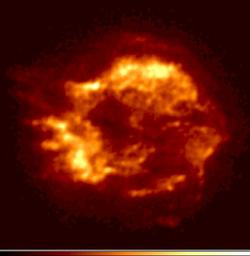A Supernova Puzzle is Resolved

Gamma radiation is a good probe of supernova remnants in our galaxy because it gives direct information on the radioactive isotopes produced by the explosions and because it’s not obscured by galactic dust. Titanium-44 ( ) gamma emission provides a particularly stringent test of theories of supernova nuclear reactions, but it has only been reliably seen at one place in the sky: the 300-year-old remnant Cassiopeia A. When it was first detected a few years ago by the Compton Gamma Ray Observatory satellite, the inferred abundance of seemed to conflict dramatically with accepted theories. But the largest uncertainty in the calculation came not from the observation, but from the half-life–three decades of lab measurements put it anywhere from 46 to 67 years. Half-lives of many years are notoriously difficult to measure, but with two papers in the 23 March PRL, several research teams report the most precise measurements yet. They used two new methods, both of which agree to within one year and give a value that puts the astrophysical controversy to rest.
Measuring a radioactive half-life of a few days is not hard: Just make a semilog plot of the number of decays per second until most of the material has decayed, and measure the slope. But for half-lives of many years, the radiation doesn’t change by very much from day to day, and long-term drifts in the instruments make it difficult to compare data taken years apart. Irshad Ahmad and his collaborators at Argonne National Laboratory in Argonne, IL, the University of Vienna, Hebrew University in Jerusalem, and Consiglio Nazionale delle Ricerche in Torino, Italy, performed identical experiments over a period of five years. Ahmad prepared samples for each lab that contained equal parts 44Ti and 60Co (which has a well-known half-life and a nearby gamma-ray emission line), and each group measured the ratio of the Ti to the Co gamma emission, thereby eliminating most of the instrumental effects. Although the ratio method has been used before, this team had the patience to collect five years worth of data with three separate instruments, all of which helped insure against systematic errors.
The other team, led by Michael Wiescher and Joachim Goerres of the University of Notre Dame in South Bend, IN, used the relatively new radioactive beam technology to make their samples in a new way. The A1200 fragment separator at Michigan State University in East Lansing allows researchers to create a beam of nuclei containing exactly the isotopes they wish and to count the nuclei individually as they are deposited into a solid material at the end of the beam line (aluminum foil, in this case). The group made samples containing precisely known amounts of and (a well-characterized isotope) and measured the ratio of the rates of gamma ray emission. This measurement, combined with the precisely known numbers of radioactive nuclei, gave the half-life to high accuracy.
The combined result from the two publications is 59.2 ± 0.6 yr, a value consistent with at least some of the accepted supernova models and which avoids the serious problems raised by previous measurements. (A third collaboration, led by Eric Norman of the Lawrence Berkeley National Laboratory in Berkeley, CA, will publish a value very close to those of these two groups in the April issueof Physical Review C.) After such widely varying measurements in the past, Wiescher’s coauthor Brad Sherrill, of Michigan State University, says he is confident. “It’s very comforting when two really independent methods agree.”


